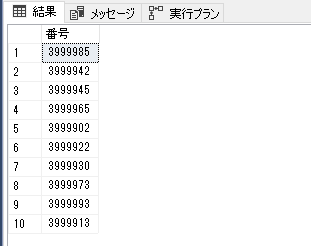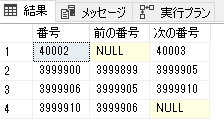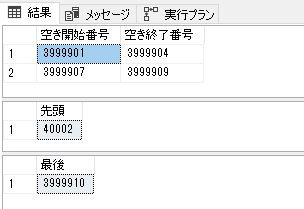決められた範囲があって、その中で空いている最小の番号を取得するってクエリ。
例:40000~4000000 までの間で未使用の番号を少ない順に10個とる。
範囲用の表を作って存在しないデータ取得
with [範囲] as ( select cast(40000 as bigint) as [番号] union all select [番号] + 1 from [範囲] where [番号] < 4000000 ), [使用済] as ( select [番号] from (values (40001), (40003), (40004), (40005), (40008), (40009), (40010)) as [t]([番号]) ) select top(10) [範囲].[番号] from [範囲] where not exists ( select * from [使用済] where [使用済].[番号] = [範囲].[番号] ) option (maxrecursion 0)
結果はこんなん

実行プランを見ると、Nested Loops の 後に Top なので、サクッと終わる。

これ option (maxrecursion 0) してるけど、実際には、10件取れるまでしかループしてないから、無くてもエラーにならない。
再帰クエリで循環参照した時にどうなるのか?(SQL Server, PostgreSQL) - お だ のスペース
で少し書いたけど、再帰クエリと Top 良い感じ。
データ増えるとどうなるかというと…
drop table if exists [使用済] create table [使用済] ( [番号] bigint ); with cte as ( -- わざと 40000, 40001 は空けてる select cast(40002 as bigint) as [番号] union all select [番号] + 1 from [cte] where [番号] < 3999900 ) insert into [使用済] select [番号] from cte option (maxrecursion 0) ; insert into [使用済] values (3999905), (3999906), (3999910) ;
with [範囲] as ( select cast(40000 as bigint) as [番号] union all select [番号] + 1 from [範囲] where [番号] < 4000000 ) select top(10) [範囲].[番号] from [範囲] where not exists ( select * from [使用済] where [使用済].[番号] = [範囲].[番号] ) option (maxrecursion 0)

めっちゃ遅いし、40000, 40001 が入ってない。。
実行プランを見ると、Nested Loop じゃなくなったので、当然結果も違う。
ってことは order by を付けないとダメなんで件数少なくても全件ループしてしまうのでこのやり方じゃダメ。*1
※order by 付けなくてもこのデータ量だと、再帰のループが多すぎて遅すぎる!

ってことで、別のやり方を。
2021/08/20 追記 範囲用のテーブルが事前にあったら?
Twitter でレスあったので試しましたが、
事前に範囲用のテーブルがあった場合は、挙げたケースの中では一番早いかな。
↑のが遅いのは再帰の回数多くてデータ作るところが問題な訳で、元からデータがあったら問題無し。
drop table if exists [範囲] ; create table [範囲] ( [番号] bigint not null primary key ) ; with cte as ( select cast(40000 as bigint) as [番号] union all select [番号] + 1 from cte where [番号] < 4000000 ) insert into [範囲] select [番号] from cte option (maxrecursion 0)
select top(10) [範囲].[番号] from [範囲] where not exists ( select * from [使用済] where [使用済].[番号] = [範囲].[番号] ) option (maxrecursion 0)
範囲が可変の場合に、どこまで事前に持たせるかってのは考え所ではあるかな~。
window 関数使って前後のデータと比較する
正直、クエリだけでやるのは大変なので、
クエリで空き番を取得するための材料を取る方向に逃げます。
LEAD (Transact-SQL) - SQL Server | Microsoft Docs と LAG (Transact-SQL) - SQL Server | Microsoft Docs を使って
-- 取り合えず11件取っとけば、空き番10個あるなら事足りる。 -- 11件なのは、先頭のデータが範囲の最小の時は、10件だと空き番10個取れない。。 select top(11) * from ( select [番号] , lag([番号]) over (order by [番号]) as [前の番号] , lead([番号]) over (order by [番号]) as [次の番号] from [使用済] ) data_ where [番号] + 1 <> [次の番号] or [次の番号] is null or [前の番号] is null order by [番号]

さっきよりは大分マシだけど、試した環境で 6秒位掛かるのでやっぱ待てないかな?
空き番取得 + 先頭 + 最後
1クエリで取るの諦めて、空き番取るだけ + 先頭 + 最後だと
-- 空き番取る select [空き開始番号], [空き終了番号] from ( select [使用済].[番号] + 1 as [空き開始番号] , ( select min([番号]) - 1 from [使用済] as [nest_] where [nest_].[番号] > [使用済].[番号] ) as [空き終了番号] from [使用済] left join [使用済] as [cond_] on [使用済].[番号] = [cond_].[番号] - 1 where [cond_].[番号] is null ) as [data_] where [空き終了番号] is not null order by 1; ; -- 先頭 select top(1) [番号] as [先頭] from [使用済] order by [番号] ; -- 最後 select top(1) [番号] as [最後] from [使用済] order by [番号] desc ;

クエリ3つ発行するけどこれが一番良さげ。
データ件数とパフォーマンスと実装のしやすさで好きなの選んだらいーんじゃないかな?
ちなみに再帰で範囲データを作ってないやつは、範囲外のデータがある可能性があるので、範囲の条件を付ける必要あるよ!
*1:最初のクエリはたまたま意図した結果が取れただけ!